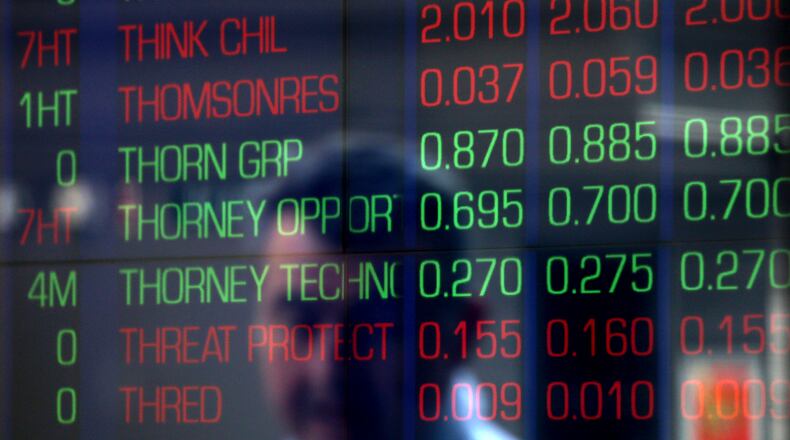Here’s what you should know:
1. Bonds turn higher: Despite the turbulence, Tuesday's trading looked similar to the patterns that have shaped the market for the last year: investors bought companies that do well when economic growth is strongest. Gainers included technology companies, retailers like Amazon and Home Depot, and industrial companies and banks.
Bond yields turned higher after a sharp drop Monday. As a result, the biggest losses went to high-dividend companies such as utility and real estate companies, which investors often buy as an alternative to bonds. When bond yields rise, those stocks become less appealing to investors seeking income. The yield on the 10-year Treasury note rose to 2.80 percent from 2.71 percent.
2. Uncertainty vs. Certainty: Rob Russell, president of Russell Total Wealth Management said the market may be reacting to "uncertainty vs. certainty." Much of the Monday's moves were triggered by "limit orders," and that action may continue, Russell warned.
Such orders ensure a stock’s automatic sale if it falls a certain percentage or down to a certain price. “I think it’s been a great ride,” he said.
“People have limit orders as the market cascades down, and they’re being automatically acted on.” We’re not yet in “correction” territory, in which a market loses 10 percent of its value, Russell said. But we may not be done, either. “This is called a market pullback,” he said. “It’s actually a healthy thing, although it doesn’t feel like it at the time.”
3. INTERNATIONAL TRADING: Stock markets around the world took a battering Tuesday, following a dramatic sell-off on Wall Street that triggered concerns that a potentially healthy pullback from record highs could morph into a more protracted crash.
Hopes that Wall Street won’t repeat the scale of Monday’s losses helped limit the selling during European trading hours. Futures markets suggested another, but more moderate drop, in the U.S., with the Dow and S&P 500 futures down 0.8 percent and 0.2 percent.
The market mood turned decidedly fearful on Monday when the Dow Jones industrial average posted its biggest percentage decline since August 2011, driven by fears the U.S. Federal Reserve will raise interest rates faster than expected due to a pick-up in wages.
4. CORRECTION MODE: William Wood, a certified financial planner with Centerville's Adams Wealth Management Group, said he expected the market to level off.
“I don’t think we’re in a correction mode, but we expected volatility in 2018, and I think this is the first example of that,” Wood said.
He thinks the market is facing “a lot of issues,” including an expected increase in interest rates. Some see inflation on the horizon as well.
Wood called Monday’s stock movements a “risk-adjusted rebalancing.” And he doesn’t think this kind of market is the kind that investors should “sell into.”
5. JOB FIGURES SEND SCARE: The catalyst for the latest sell-off on Monday came in jobs figures last Friday showing that wage growth in the U.S. was creeping higher. For many traders, that was a sign that the Fed will have to pick up the pace of its rate hikes — higher wages have the capacity to fuel inflation.
On Monday, the Dow finished down 4.6 percent at 24,345.75, while the S&P 500 sank 4.1 percent, to 2,648.94. Falls like this have not been registered since August 2011 when investors were fretting over Europe’s debt crisis and the debt ceiling impasse in Washington that prompted a U.S. credit rating downgrade.
Still, while some financial assets became more attractive to investors as perceived havens of value. Gold, for example, was up 0.4 percent at $1,343 an ounce.
The U.S. dollar remained resilient despite the stock market sell-off, which at one stage Monday saw the Dow shed 1,597 points. The euro was up 0.3 percent at $1.2435 while the dollar rose 0.3 percent to 109.38 yen.
6. DON'T PANIC: On Oct. 25 1929, a Friday, the Dow Jones Industrial Average closed at 301. The following Monday, dubbed "Black Monday" in trading lore, the Dow closed at 260, a drop of 13.5 percent. Then the next day, called "Black Tuesday," the Dow fell to 230 points, a loss of 11.7 percent.
People were in a panic after only two days of steep losses. On Wednesday, which has no moniker, the Dow reversed course and rose up to 259. This rise almost entirely wiped out the previous day’s fall.
In other words, in the space of less than 36 hours, the Dow fell and then rose around 12 percent. This whipsaw action means the stock market is not a place for investors who are faint of heart – and many people’s savings and investments were wiped out as a result. But it also means that just because the stock market has large losses today does not means these large losses won’t be quickly reversed in the future (perhaps even as you read this article, the market is going up again).
The Associated Press contributed to this story.
About the Author

